Doug Kerr
Well-known member
The Trinity Test - the world's first nuclear explosion, on July 16. 1945 - plays an important role in the lore of Alamogordo. New Mexico - the nearest town of any size to the test site (about 60 miles away). In fact, people here are classified into two groups - the downwinders and the upwinders. The downwinders were "downwind" from the detonation, and thus fell under the potential influence of the cloud of radioactive material that drifted to the northeast.
Curiously enough, today's mountain artist colonies of Cloudcroft and Ruidoso were all downwind. Alamogordo, now dull and conservative, full of missile scientists, was upwind. I was in Cincinnati at the time
I will be releasing a number of notes devoted to the Trinity test. These will consummate this October, when the Trinity Site (including the McDonald Ranch House) is open to the public for one day (only happens twice a year).
This note is on the McDonald Ranch house, where the first nuclear bomb was finally assembled.
******
In 1912, when New Mexico had just become a state, German-born Franz Schmidt took up ranching under a lease on a gigantic tract of government-owned land in southern New Mexico, not too far (in New Mexico terms) from the tiny wide spot in the road, San Antonio, New Mexico. He built a sturdy adobe ranch house there. It was in a region that had the traditional (and ominous ) Spanish Name, El Jornado del Muerte (the journey of death)
Some time in the 1930's, George McDonald bought the house from Schmidt, and enlarged it a bit and added some further amenities. He operated his ranching operation from it. (Goats were a part of his stock.)
In December, 1941, immediately after the outbreak (for the US) of World War II, the U.S government canceled all private grazing leases on this tract, preparatory to forming the Alamogordo Bombing and Gunnery range (now part of the White Sands Missile Range), and forced McDonald to leave. I don't know (yet) whether McDonald was compensated for the loss of the ranch house.
In late 1944, officials of the Manhattan Project, the project to develop an atomic bomb, realizing that they would (hopefully) soon need to conduct a live test of a nuclear weapon, being considering various sites. The final choice was in El Jornado del Muerte, with Ground Zero about two miles south of the McDonald house.
The decision was to finally assemble The Gadget, as the test item was called, on site. The McDonald Ranch House, somewhat deteriorated but still sound, was rudely rehabilitated to be the final assembly shop.
The story of the preparations for the test, and of the journey of the plutonium "core", from the laboratory at Los Alamos to this remote desert site, are fascinating, and I'll regale you with them in due course.
But for now we will concentrate on the house.
Well mostly.
Here, we see the house at an unknown date, probably after it was restored in the 1980's when the Trinity Site was being prepared for public viewing.
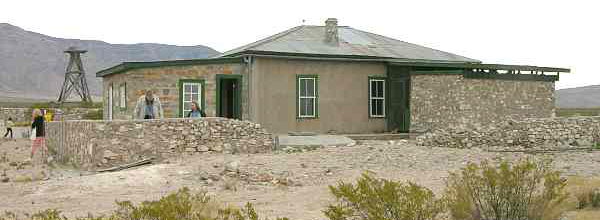
The McDonald Ranch House from the rear
Here, in July, 1945, Sgt. Herbert Lehr carries the plutonium core ("pit") for The Gadget, in its special carrying case, into the assembly room at the McDonald Ranch house.
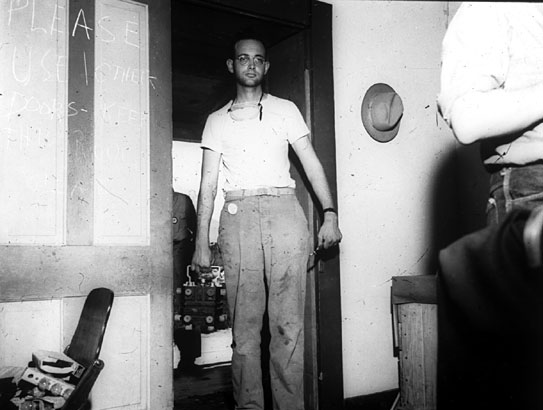
The plutonium core of The Gadget arrives
It had been driven to the site in the back seat of a olive-drab 1942 Plymouth sedan, J. Robert Oppenheimer's official car.
The manufacturing cost of the plutonium in the "pit" was about $3 billion (1945 dollars). There was just enough plutonium-238 at the time to build this bomb and one more, the one that was dropped on Nagasaki, Japan, three weeks later
Again,we will discuss the test in detail later. For now, suffice it to say that it worked - and very well. Here we see the result 16 milliseconds after initiation (the fireball is abut 600 feet wide here):
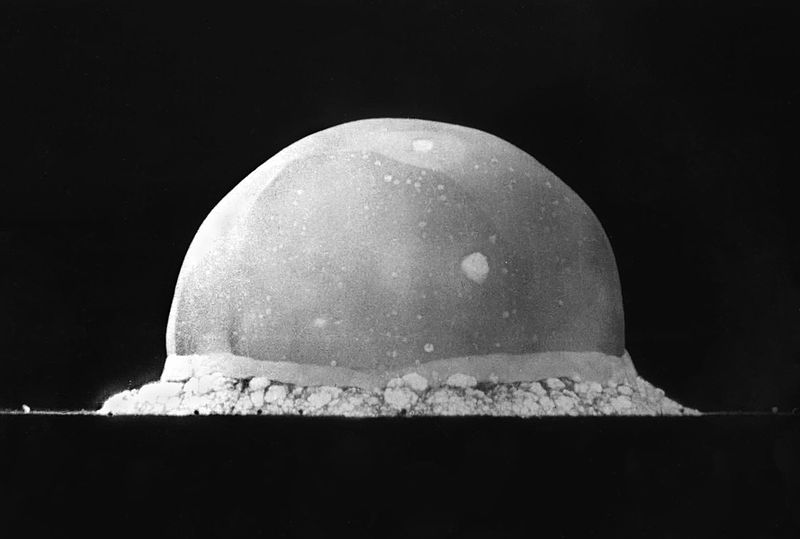
The Trinity fireball at 16 milliseconds
The McDonald Ranch House, only two miles away, survived. Wonderful engineers, the Germans and the Scots.
Here we see it from the front:
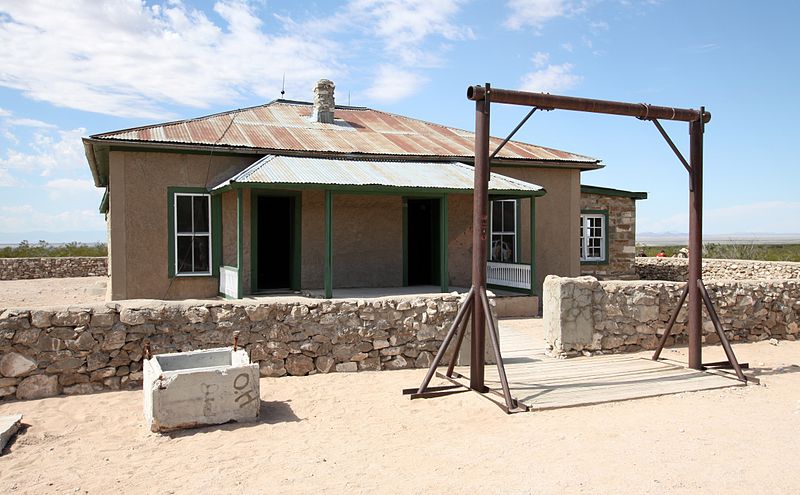
The McDonald Ranch House from the front
The cattle guard seen at the gate entrance was presumably meant to prevent cows and such from wandering into the house.
The entrance door to the right led to the room where The Gadget was assembled.
Now, closing the loop: today, Carla and I had lunch with our friend Clif McDonald, son of George McDonald, who grew up in the ranch house, at a socio-political event. Clif is an important historian of the Alamogordo area. And what a story teller. There was the time when, as a young fellow, he took this herd of goats across the lava fields west of Carizozo - but that's a story for another time.
But he still has goats. They are in a meadow next to his son's restaurant (where we ate today).
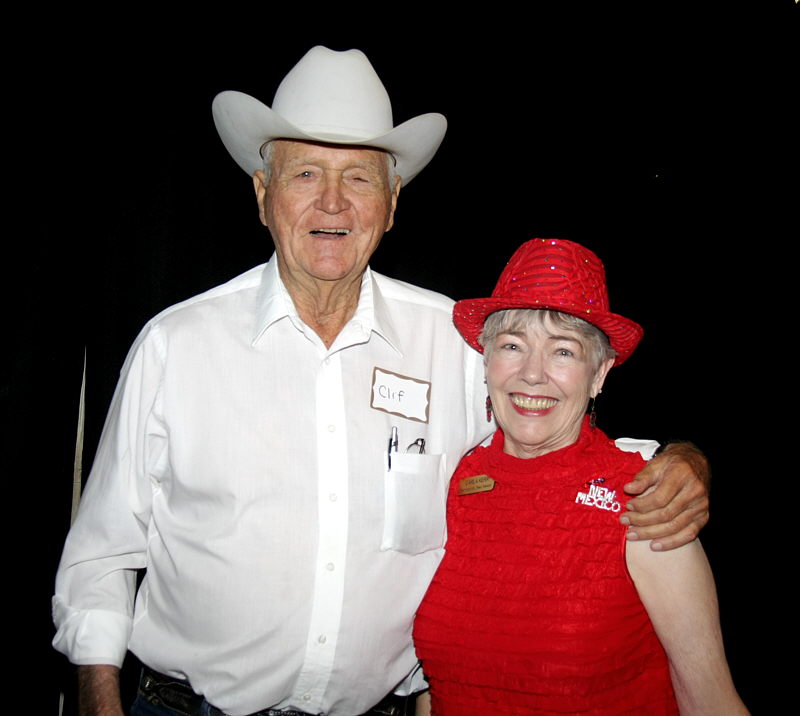
Douglas A. Kerr: Clif McDonald and Carla Kerr
Best regards,
Doug
Curiously enough, today's mountain artist colonies of Cloudcroft and Ruidoso were all downwind. Alamogordo, now dull and conservative, full of missile scientists, was upwind. I was in Cincinnati at the time
I will be releasing a number of notes devoted to the Trinity test. These will consummate this October, when the Trinity Site (including the McDonald Ranch House) is open to the public for one day (only happens twice a year).
This note is on the McDonald Ranch house, where the first nuclear bomb was finally assembled.
******
In 1912, when New Mexico had just become a state, German-born Franz Schmidt took up ranching under a lease on a gigantic tract of government-owned land in southern New Mexico, not too far (in New Mexico terms) from the tiny wide spot in the road, San Antonio, New Mexico. He built a sturdy adobe ranch house there. It was in a region that had the traditional (and ominous ) Spanish Name, El Jornado del Muerte (the journey of death)
Some time in the 1930's, George McDonald bought the house from Schmidt, and enlarged it a bit and added some further amenities. He operated his ranching operation from it. (Goats were a part of his stock.)
In December, 1941, immediately after the outbreak (for the US) of World War II, the U.S government canceled all private grazing leases on this tract, preparatory to forming the Alamogordo Bombing and Gunnery range (now part of the White Sands Missile Range), and forced McDonald to leave. I don't know (yet) whether McDonald was compensated for the loss of the ranch house.
In late 1944, officials of the Manhattan Project, the project to develop an atomic bomb, realizing that they would (hopefully) soon need to conduct a live test of a nuclear weapon, being considering various sites. The final choice was in El Jornado del Muerte, with Ground Zero about two miles south of the McDonald house.
The decision was to finally assemble The Gadget, as the test item was called, on site. The McDonald Ranch House, somewhat deteriorated but still sound, was rudely rehabilitated to be the final assembly shop.
The story of the preparations for the test, and of the journey of the plutonium "core", from the laboratory at Los Alamos to this remote desert site, are fascinating, and I'll regale you with them in due course.
But for now we will concentrate on the house.
Well mostly.
Here, we see the house at an unknown date, probably after it was restored in the 1980's when the Trinity Site was being prepared for public viewing.
The McDonald Ranch House from the rear
Here, in July, 1945, Sgt. Herbert Lehr carries the plutonium core ("pit") for The Gadget, in its special carrying case, into the assembly room at the McDonald Ranch house.

The plutonium core of The Gadget arrives
Courtesy of Wikimedia Commons
It had been driven to the site in the back seat of a olive-drab 1942 Plymouth sedan, J. Robert Oppenheimer's official car.
The manufacturing cost of the plutonium in the "pit" was about $3 billion (1945 dollars). There was just enough plutonium-238 at the time to build this bomb and one more, the one that was dropped on Nagasaki, Japan, three weeks later
Again,we will discuss the test in detail later. For now, suffice it to say that it worked - and very well. Here we see the result 16 milliseconds after initiation (the fireball is abut 600 feet wide here):

The Trinity fireball at 16 milliseconds
Courtesy of Wikimedia Commons
The McDonald Ranch House, only two miles away, survived. Wonderful engineers, the Germans and the Scots.
Here we see it from the front:

The McDonald Ranch House from the front
Courtesy of Wikimedia Commons
The cattle guard seen at the gate entrance was presumably meant to prevent cows and such from wandering into the house.
The entrance door to the right led to the room where The Gadget was assembled.
Now, closing the loop: today, Carla and I had lunch with our friend Clif McDonald, son of George McDonald, who grew up in the ranch house, at a socio-political event. Clif is an important historian of the Alamogordo area. And what a story teller. There was the time when, as a young fellow, he took this herd of goats across the lava fields west of Carizozo - but that's a story for another time.
But he still has goats. They are in a meadow next to his son's restaurant (where we ate today).

Douglas A. Kerr: Clif McDonald and Carla Kerr
Best regards,
Doug
